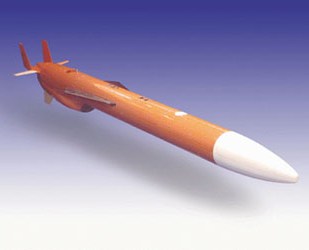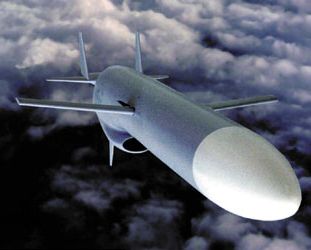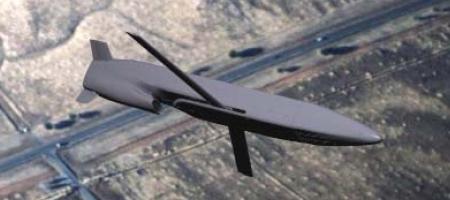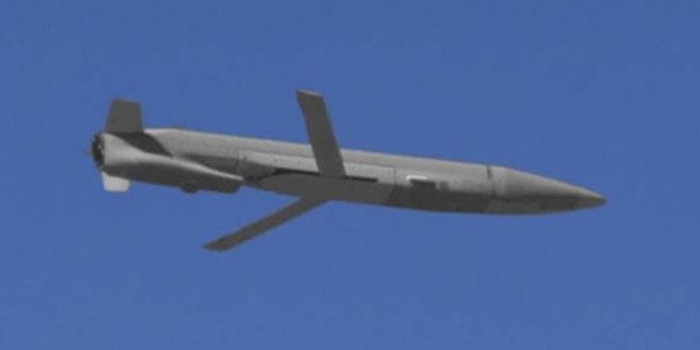Northrop Grumman (Teledyne Ryan) ADM-160A MALD
Raytheon ADM-160B/C MALD
In 1995, DARPA initiated the MALD (Miniature Air-Launched Decoy) ACTD (Advanced Concept Technology Demonstration) program, and in November 1996, Teledyne Ryan (now Northrop Grumman) was awarded a development contract for the ADM-160A flight vehicle. The ACTD called for a small low-cost expendable decoy for SEAD (Suppression of Enemy Air Defense) missions. The first flight of an ADM-160A occurred in January 1999, and the test and evaluation program had been completed by 2001.
The ADM-160A was powered by a Hamilton Sundstrand TJ-50 miniature turbojet, and had flip-out wings for compact carriage. It used a GPS-aided navigation system, and could fly missions with up to 256 predefined waypoints. The mission profile was preprogrammed, but could be redefined by the pilot of the launching aircraft until immediately before launch. MALD's main mission payload was a Northrop Grumman SAS (Signature Augmentation Subsystem) with various active radar enhancers for a range of frequencies. The SAS could simulate any aircraft in the inventory, from large-RCS B-52Hs to low-observable stealth aircraft.
 |
 | |
| Images: Northrop Grumman | ||
| ADM-160A | ||
The ADM-160A could be carried by all current tactical strike aircraft of the U.S. military, and the USAF at one time planned to procure several 1000 MALDs. This requirement had been drastically reduced over time, partially because of increasing costs. In late 2001, the Air Force planned to procure about 150 ADM-160As beginning in 2003 for an SDD (System Development and Demonstration) program. The SDD was also to evaluate other MALD derivatives, including an active radar-jamming vehicle. However, after initial delays of the SDD, because the USAF could not determine the desired configuration of the SDD vehicles, the MALD program was effectively ended by the Air Force.
The MALI (Miniature Air-Launched Interceptor) was an armed derivative of MALD, for possible use against cruise missiles. MALI had a sharper nose profile, increased wing swep, and a more powerful (0.53 kN (120 lb) thrust) TJ-50M engine for short supersonic performance. An IIR (Imaging Infrared) seeker was used for terminal homing on the target, and mid-course guidance was via a command link to air surveillance platforms like the E-3 AWACS. The MALI has undergone a test and development program, which ended in December 2002, when the first supersonic flight was made.
In late 2002, the USAF opened an industry-wide competition for further development and procurement of MALD, and all major American aerospace companies expressed interest. In May 2003, the award of an SDD contract to Raytheon was announced, and at the same time, the designation ZADM-160B was assigned to the forthcoming design. The Raytheon ADM-160B design has a completely different airframe than the ADM-160A, and is also larger and heavier. It is powered by a Sundstrand TJ-150 turbojet.
 |
| Image: Raytheon |
| ZADM-160B |
Between May and July 2006, ADM-160B prototype vehicles were successfully released from F-16s in a series of nine flight tests. The first powered flight of an ADM-160B finally occurred in June 2007. The first production representative vehicles were delivered in 2009, and by 2010, ADM-160B decoys began to reach USAF units in significant numbers. The DATM-160B is a completely inert variant for load crew training.
 |
| Photo: Raytheon |
| ADM-160B |
In 2009, Raytheon started to develop the ADM-160C MALD-J (MALD Jammer) version. It is a derivative of the ADM-160B, which employs active radar jamming systems. It cooperates with other EW (Electronic Warfare) assets, and is designed as an expendable stand-in system to disrupt the enemy's early warning and target acquisition/tracking radars. The first ADM-160Cs were delivered to the Air Force in 2012, and IOC was declared in 2015. The ADM-160B/C can be carried by all USAF strike aircraft, and as of 2020, the Air Force planned to procure up to 3000 ADM-160s, most of them as the MALD-J variant.
By 2018, Raytheon was working on an enhanced version named MALD-X. It featured improved electronic warfare payloads, was designed for low-level operation, and had networking/swarming capabilities. In the same year, the U.S. Navy began to award contracts to Raytheon for a Navy-specific MALD-N variant, based on MALD-X. IOC of MALD-N was reached in 2022.
Specifications
Note: Data given by several sources show slight variations. Figures given below may therefore be inaccurate!
Data for ADM-160A/B:
| ADM-160A | ADM-160B | |
|---|---|---|
| Length | 2.38 m (7 ft 9.8 in) | 2.85 m (9 ft 4 in) |
| Wingspan | 0.65 m (2 ft 1.4 in) | 1.71 m (5 ft 7 in) |
| Diameter | 15.2 cm (6 in) | n/a |
| Weight | 45 kg (100 lb) | 110 kg (250 lb) |
| Speed | Mach 0.8 | Mach 0.91 |
| Ceiling | > 9000 m (30000 ft) | > 12200 m (40000 ft) |
| Range | > 460 km (250 nm) | 925 km (500 nm) |
| Endurance | > 20 min | 90 min |
| Propulsion | Hamilton Sundstrand TJ-50 turbojet; 0.22 kN (50 lb) | Hamilton Sundstrand TJ-150 turbojet; 1.5 kN (340 lb) |
Main Sources
[1] Kenneth Munson (ed.): "Jane's Unmanned Aerial Vehicles and Targets, Issue 15", Jane's, 2000
[2] DARPA Website
[3] Graham Warwick: "Low-cost cruise killer in first supersonic flight", article in "Flight International", 17-30 December 2002
[4] Raytheon Website
[5] Air&Space Forces Magazine: ADM-160 MALD
[6] Various web resources, referenced by Wikipedia:
Back to Current Designations Of U.S. Unmanned Military Aerospace Vehicles
Back to Directory of U.S. Military Rockets and Missiles
Last Updated: 4 January 2025